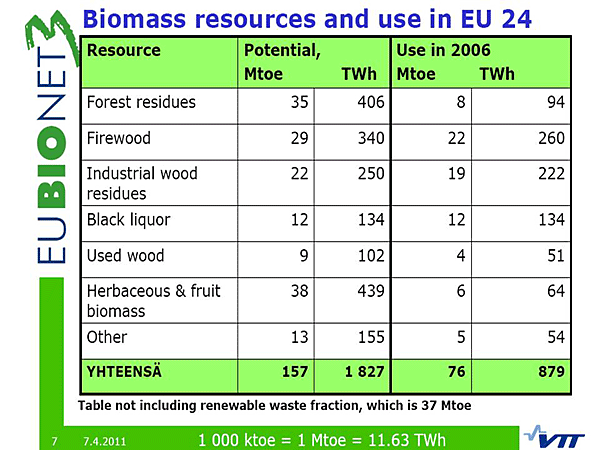New Study Examines EU Biomass Fuel Potential
 Print this article | Send to Colleague Print this article | Send to Colleague
Agrobiomass and forest chips are the most underused bioenergy sources available today, and there is potential for increasing their use by 50% from current levels, according to a new study on Biomass Fuel Markets in Europe conducted as part of the EUBIONET III project coordinated by VTT Technical Research Centre of Finland. The study, which ran from 2008 to 2011, generated more accurate information than ever before available on biomass reserves in the EU.
The EUBIONET III project involved estimating the biomass potential in 23 EU member states and Norway. The annual potential for biomaterial gained from forests, fields, and industry was eventually estimated at the equivalent of 157 million metric tons of oil.
"In this project, we focused on the technical and economic potential of biomass reserves and on solid biofuels. If we further assume that about half the waste generated in the EU is biodegradable, that would translate into the equivalent of about 37 million metric tons of oil, bringing the total available biomass up to some 200 million metric tons of oil," says Senior Research Scientist Eija Alakangas from VTT, who was in charge of the project.
Since the publication of the report, the countries involved have estimated in their national renewable energy action plans that about 250 million metric tons of biomass reserves would be required to achieve the combined goals set. It has not yet been estimated at the EU level what the volume required for sustainable development might be. Moreover, some countries import their biomass fuel from other EU Member States or from outside of the EU.
"Current use of bioenergy exploits less than half the bioenergy potential of the 24 EU member states studied. The greatest potential for increase is in forest chips and agrobiomass. Finland aims to use forest chips to produce energy equivalent to the yield of 13.5 million cubic meters of solid fuel, or 25 TWh (1 TWh = 1 billion kWh of energy / 1 million metric tons of oil (Mtoe) equals 11.63 TWh of energy)," says Alakangas.
In addition to exploring the biofuel potential of the EU and its sufficiency, the project studied sustainable development criteria for solid biofuels, generated information for use in standardization, and monitored biofuel price development since 1999. The project yielded information useful for new quality standards for solid biofuels, and a price index for international trade was developed together with businesses.
Also, wood pellet trade was evaluated in the project, using customs codes and by collecting price data on biomass fuels. FOEX Indexes publishes an industrial pellet index based on prices in the Baltic Sea region, and in the future this will be extended to include forest chips. The FOEX index is based on actual sales. Information has also been gathered in countries not covered by the price index.
Following the project, a new customs code will be introduced for wood pellets to monitor the pellet trade from 2012. Major exporters of wood pellets to the EU include the USA, Canada and Russia. Most of the imported wood pellets are blended with coal and used at large power plants.
Graphic summaries of data from the study are available online.

|

